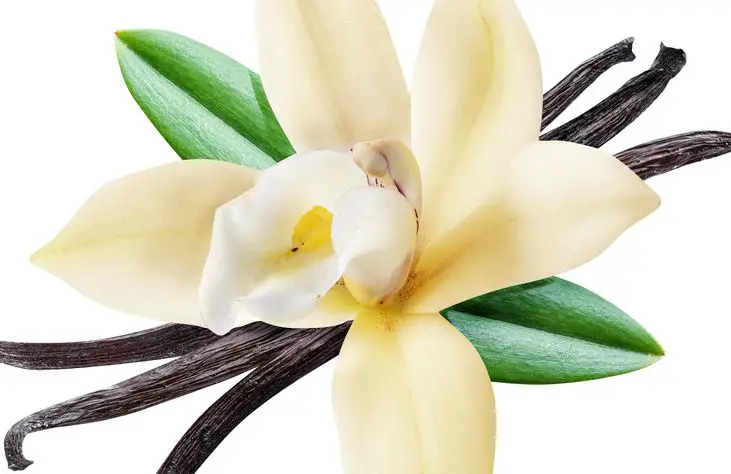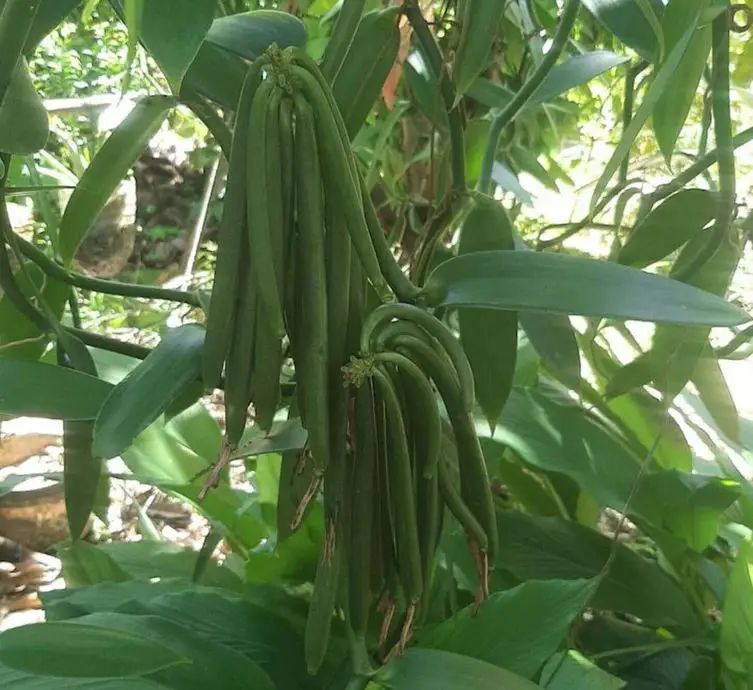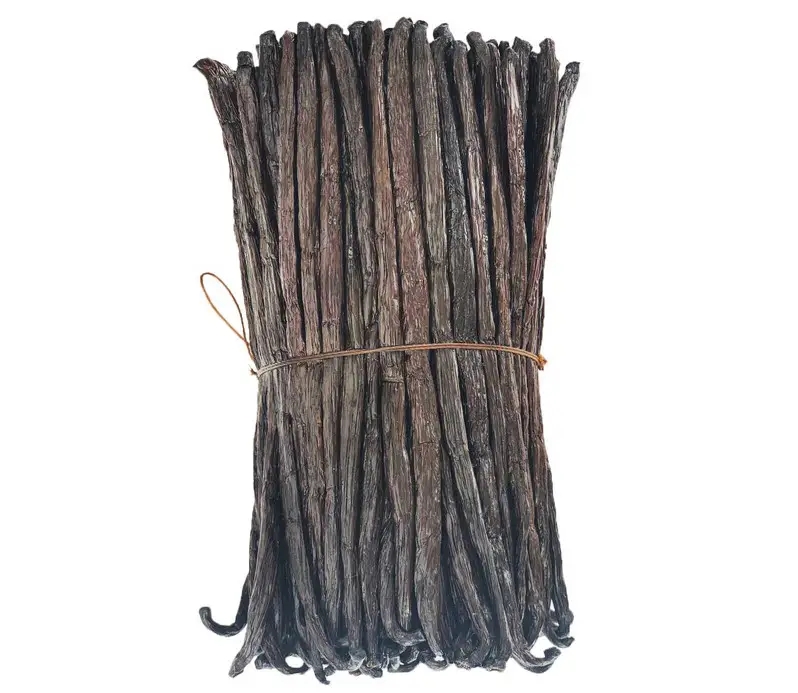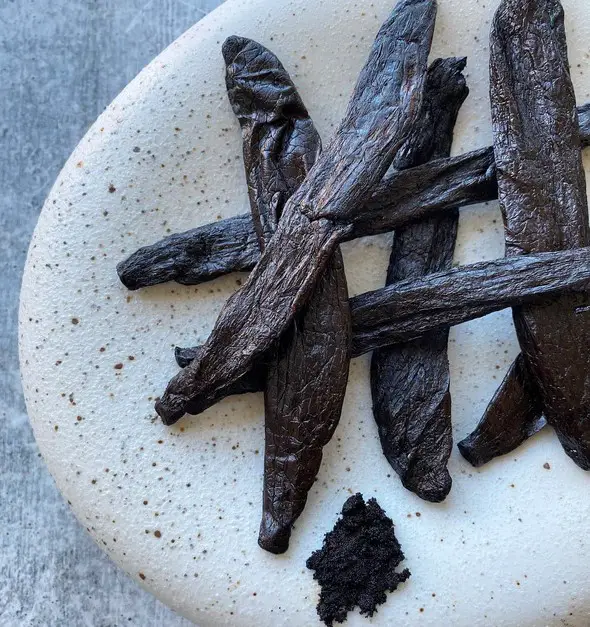Podcast: Play in new window | Download
Subscribe: Apple Podcasts | RSS
I’ve gone to Mexico so many times on buying trips for my imports business, and it seems that whenever I go, I get special requests from family and friends for vanilla. I’m not talking about the bean or the tiny bottle of vanilla extract you see in American supermarkets. People want the 1-liter dark-glass bottle with the yellow label on it. It’s fantastic for all your baking needs and it’s inexpensive, and like anything liquid in a bottle coming from Mexico – whether it’s tequila or Fabuloso – a little goes a long way. I am happy to oblige when people come to me with these requests and make sure that I have extra room in my checked luggage. I never really thought about the history of vanilla or what went into making it until I saw the beans being sold in a mercado in the Yucatán. Like maize discussed in Mexico Unexplained episode number 86 https://mexicounexplained.com/story-maize-mexicos-gift-world/ or chocolate found in episode 267 https://mexicounexplained.com/cacao-from-currency-to-chocolate/ vanilla is one of Mexico’s gifts to the world.
 The plant which produces the vanilla seed pod is a member of the orchid family called Vanilla planifolia which was originally native to the coastal forests stretching from the Mexican state of Veracruz all the way to Colombia on the eastern side of the Americas and from the Mexican state of Colima all the way down to Ecuador on the western side of the Americas. The ancient Maya and even the Olmecs before them may have been the first peoples to engage in wild gathering or even small-scale cultivation of vanilla. There is evidence that they used vanilla flavoring to enhance their chocolate drinks, and as vanilla production is labor-intensive, it may have only been used by the nobility and the priestly classes, and only during special occasions. The Totonacs, a civilization discussed in Mexico Unexplained episode number 179 https://mexicounexplained.com/the-totonacs-a-forgotten-civilization/ were the first Mesoamerican people to grow vanilla on a large scale. In their language, they called vanilla, and still call it to this day, xanath. The richest source of vanilla in ancient times seems to have come from the Papantla region located in what is now the north-central part of the Mexican state of Veracruz. Researchers believe that the Totanacs began their larger vanilla-growing operations sometime between 1100 and 1200 AD. The Totonacs saw vanilla as a sacred herb and used it in medicine, perfumes, and ritual offerings. The bean was also fashioned into amulets and charms which were used to attract good fortune and abundance. According to Totonac folklore, the vanilla orchid was once a woman and the tree it grows on was once a man who both lost their human forms by displeasing the gods. In the ancient and sacred groves where vanilla was first cultivated, those entering the area to tend to the vines were only permitted access to the plants from a space of joy and love. Anyone in a bad mood or with ill intentions was not allowed near the vanilla plants because the Totonacs believed that negative emotions would have bad effects on the flowers and cause them to shrivel and die. So, there was a mental preparation one needed to undergo before approaching the plants, a sort of emotional cleansing. The Totonacs rarely used vanilla as a simple flavoring like the way the Maya and Olmecs had used it before.
The plant which produces the vanilla seed pod is a member of the orchid family called Vanilla planifolia which was originally native to the coastal forests stretching from the Mexican state of Veracruz all the way to Colombia on the eastern side of the Americas and from the Mexican state of Colima all the way down to Ecuador on the western side of the Americas. The ancient Maya and even the Olmecs before them may have been the first peoples to engage in wild gathering or even small-scale cultivation of vanilla. There is evidence that they used vanilla flavoring to enhance their chocolate drinks, and as vanilla production is labor-intensive, it may have only been used by the nobility and the priestly classes, and only during special occasions. The Totonacs, a civilization discussed in Mexico Unexplained episode number 179 https://mexicounexplained.com/the-totonacs-a-forgotten-civilization/ were the first Mesoamerican people to grow vanilla on a large scale. In their language, they called vanilla, and still call it to this day, xanath. The richest source of vanilla in ancient times seems to have come from the Papantla region located in what is now the north-central part of the Mexican state of Veracruz. Researchers believe that the Totanacs began their larger vanilla-growing operations sometime between 1100 and 1200 AD. The Totonacs saw vanilla as a sacred herb and used it in medicine, perfumes, and ritual offerings. The bean was also fashioned into amulets and charms which were used to attract good fortune and abundance. According to Totonac folklore, the vanilla orchid was once a woman and the tree it grows on was once a man who both lost their human forms by displeasing the gods. In the ancient and sacred groves where vanilla was first cultivated, those entering the area to tend to the vines were only permitted access to the plants from a space of joy and love. Anyone in a bad mood or with ill intentions was not allowed near the vanilla plants because the Totonacs believed that negative emotions would have bad effects on the flowers and cause them to shrivel and die. So, there was a mental preparation one needed to undergo before approaching the plants, a sort of emotional cleansing. The Totonacs rarely used vanilla as a simple flavoring like the way the Maya and Olmecs had used it before.
 Vanilla made its way across the trade routes of ancient Mexico, but it wasn’t a commodity in high demand and generally had limited use and acceptance outside the Totonac’s home territory. When the Aztec Empire started gaining power in the central highlands of Mexico in the 1300s, vanilla got the attention of the Aztec rulers. In the year 1427 the Aztecs defeated the Totonacs and subjugated their kingdom, incorporating it into their empire. Soon, the nobles in the Aztec capital of Tenochtitlán acquired a taste for vanilla, and this sacred herb of the Totonacs became a commodity to be paid to the Aztec Empire in tribute. The Aztecs called vanilla tlilxoxitl, which literally means, “black flower,” because the mature bean shrivels and turns black before it is harvested. Aztec chefs used tlilxoxitl as a sweetener in a variety of dishes, but vanilla was primarily used in the Aztecs’ most famous drink, which approximated modern-day hot chocolate. When Emperor Montezuma welcomed the Spanish conquistadors as honored guests to his capital city, one of the first things he served to the newcomers was the chocolate drink spiced with vanilla. Sipping this delightful drink in the comfort of the Aztec imperial palace, Cortés knew he had to present this exotic beverage to the members of the Spanish court, which he did. Soon, vanilla-infused chocolate drinks became all the rage in Spain and the king of Spain himself showed a particular fondness for them. The Spanish had a difficult time pronouncing the Nahuatl name for vanilla – tlilxoxitl – and did not even attempt to Hispanicize the native name, so they started calling it vainilla, which in English means “little pod.” The name stuck, but the old Nahuatl name was still in use for many years in New Spain. The plant was described in the Florentine Codex compiled in 1580 by Aztec scribes who were still calling it tlilxoxitl.
Vanilla made its way across the trade routes of ancient Mexico, but it wasn’t a commodity in high demand and generally had limited use and acceptance outside the Totonac’s home territory. When the Aztec Empire started gaining power in the central highlands of Mexico in the 1300s, vanilla got the attention of the Aztec rulers. In the year 1427 the Aztecs defeated the Totonacs and subjugated their kingdom, incorporating it into their empire. Soon, the nobles in the Aztec capital of Tenochtitlán acquired a taste for vanilla, and this sacred herb of the Totonacs became a commodity to be paid to the Aztec Empire in tribute. The Aztecs called vanilla tlilxoxitl, which literally means, “black flower,” because the mature bean shrivels and turns black before it is harvested. Aztec chefs used tlilxoxitl as a sweetener in a variety of dishes, but vanilla was primarily used in the Aztecs’ most famous drink, which approximated modern-day hot chocolate. When Emperor Montezuma welcomed the Spanish conquistadors as honored guests to his capital city, one of the first things he served to the newcomers was the chocolate drink spiced with vanilla. Sipping this delightful drink in the comfort of the Aztec imperial palace, Cortés knew he had to present this exotic beverage to the members of the Spanish court, which he did. Soon, vanilla-infused chocolate drinks became all the rage in Spain and the king of Spain himself showed a particular fondness for them. The Spanish had a difficult time pronouncing the Nahuatl name for vanilla – tlilxoxitl – and did not even attempt to Hispanicize the native name, so they started calling it vainilla, which in English means “little pod.” The name stuck, but the old Nahuatl name was still in use for many years in New Spain. The plant was described in the Florentine Codex compiled in 1580 by Aztec scribes who were still calling it tlilxoxitl.
 As vanilla was still seen as a luxury good, few outside of the wealthy classes in Spain could afford it and it wasn’t consumed to any great extent beyond Spain’s borders. In 1602 vanilla made it to the English-speaking world through the apothecary of England’s Queen Elizabeth the First, a man named Hugh Morgan. Morgan was the first European to take vanilla out of chocolate drinks and created vanilla-flavored candies and confections, called “sweetmeats” in the English of the day. These were very popular among the English upper classes. Soon, vanilla was being used in England and throughout Europe in baking. By the mid-1700s, the French had added vanilla to ice cream.
As vanilla was still seen as a luxury good, few outside of the wealthy classes in Spain could afford it and it wasn’t consumed to any great extent beyond Spain’s borders. In 1602 vanilla made it to the English-speaking world through the apothecary of England’s Queen Elizabeth the First, a man named Hugh Morgan. Morgan was the first European to take vanilla out of chocolate drinks and created vanilla-flavored candies and confections, called “sweetmeats” in the English of the day. These were very popular among the English upper classes. Soon, vanilla was being used in England and throughout Europe in baking. By the mid-1700s, the French had added vanilla to ice cream.
Vanilla orchids were taken to other tropical regions of the world, but cultivation of the vanilla beans had a zero success rate. The first vanilla plantations outside of Mexico were set up in 1819 on two French possessions in the Indian Ocean: Réunion Island and Mauritius. Scientists and plant enthusiasts were baffled as to why only plants grown in Mexico produced the coveted bean. Unknown to botanists at the time, the reason why the plants taken to other parts of the world were barren had to do with pollination. A small bee only found in the tropical Americas is the chief pollinator of the plant. As a historical aside, along with vanilla, the rare honey from this bee was also recorded in the tribute records as being part of the taxes the Totonacs had to pay to the Aztec Empire. The pollination and bean production mysteries were solved in 1836 when a Belgian horticulturist named Charles Morren made the connection between the bee native to Mexico and the pollination of the vanilla flower. Five years later, in 1841, a 12-year-old slave boy on the island of Réunion named Edmond Albius invented a way to pollinate the vanilla flower manually. This painstaking and laborious method of hand pollination is still in use today, even in Mexico on the larger commercial plantations. With that brilliant pollination invention came an exponential growth in the vanilla industry. Vanilla cultivation first spread through the French possessions in the Indian Ocean and Africa, including the Comoro Islands, the Seychelles and Madagascar. The latter island rivals Mexico as one of the top vanilla producers in the world today.
 Because of the labor-intensive nature behind producing vanilla, only about 1% of items made with a vanilla scent or flavor have real vanilla in them. Here’s a brief overview of the production process: First, the vanilla orchids must be grown, and it takes about a year and a half before the vine produces its first flowers. Flowers then must be pollinated. As mentioned earlier, this is done mostly by hand. The flower opens only a few hours per day, and after a few days, it wilts and dies if it is not pollinated. If pollination is successful, the flower will produce a long green bean in a few weeks. That bean must stay on the vine for 9 months to develop the proper fragrance and flavor, which varies according to where the bean is grown. Vanilla grown in Indonesia is said to have a smokier flavor than the Tahitian varieties which display floral qualities. By comparison, the original vanilla grown in Mexico has spicy and woody tones. Bourbon vanilla has rum-like characteristics in its aroma and flavor. After 9 months on the vine, the vanilla beans go through a complex curing and drying process after picking. This is to halt the beans’ natural fermentation. Beans are blanched in hot water and heated in ovens before being set out in the sun to dry for weeks or sometimes months. After sun-drying, vanilla beans are placed in boxes so that they lose their remaining moisture. The whole process from pollination of the vanilla orchid to the unboxing of the finished beans takes about a year. The beans are then culled, sorted, and packaged for whatever ultimate use they are intended.
Because of the labor-intensive nature behind producing vanilla, only about 1% of items made with a vanilla scent or flavor have real vanilla in them. Here’s a brief overview of the production process: First, the vanilla orchids must be grown, and it takes about a year and a half before the vine produces its first flowers. Flowers then must be pollinated. As mentioned earlier, this is done mostly by hand. The flower opens only a few hours per day, and after a few days, it wilts and dies if it is not pollinated. If pollination is successful, the flower will produce a long green bean in a few weeks. That bean must stay on the vine for 9 months to develop the proper fragrance and flavor, which varies according to where the bean is grown. Vanilla grown in Indonesia is said to have a smokier flavor than the Tahitian varieties which display floral qualities. By comparison, the original vanilla grown in Mexico has spicy and woody tones. Bourbon vanilla has rum-like characteristics in its aroma and flavor. After 9 months on the vine, the vanilla beans go through a complex curing and drying process after picking. This is to halt the beans’ natural fermentation. Beans are blanched in hot water and heated in ovens before being set out in the sun to dry for weeks or sometimes months. After sun-drying, vanilla beans are placed in boxes so that they lose their remaining moisture. The whole process from pollination of the vanilla orchid to the unboxing of the finished beans takes about a year. The beans are then culled, sorted, and packaged for whatever ultimate use they are intended.
Some people speculate that the insatiable appetite for real vanilla may be its undoing. The pressure is on the natural farmers and the plantations alike to produce massive amounts of vanilla. It is estimated that an average American consumes the equivalent of 2 vanilla beans a year. That may not seem like much, but it adds up to about 670 million vanilla beans annually. Whatever the world demand, the small farmers in Mexico will most likely continue to produce vanilla the way they always have with no concern for world commodity prices or international market pressures. The traditions of vanilla cultivation dating back thousands of years will continue long into the foreseeable future.
REFERENCES
Rain, Patricia. Vanilla: The Cultural History of the World’s Favorite Flavor and Fragrance. New York: J. P. Tarcher/Penguin, 2004. We are Amazon affiliates. Purchase the book on Amazon here: https://amzn.to/3MJRZOe
Sethi, Simran. “The Bittersweet Story of Vanilla.” Smithsonian Magazine. 3 Apr 2017.
